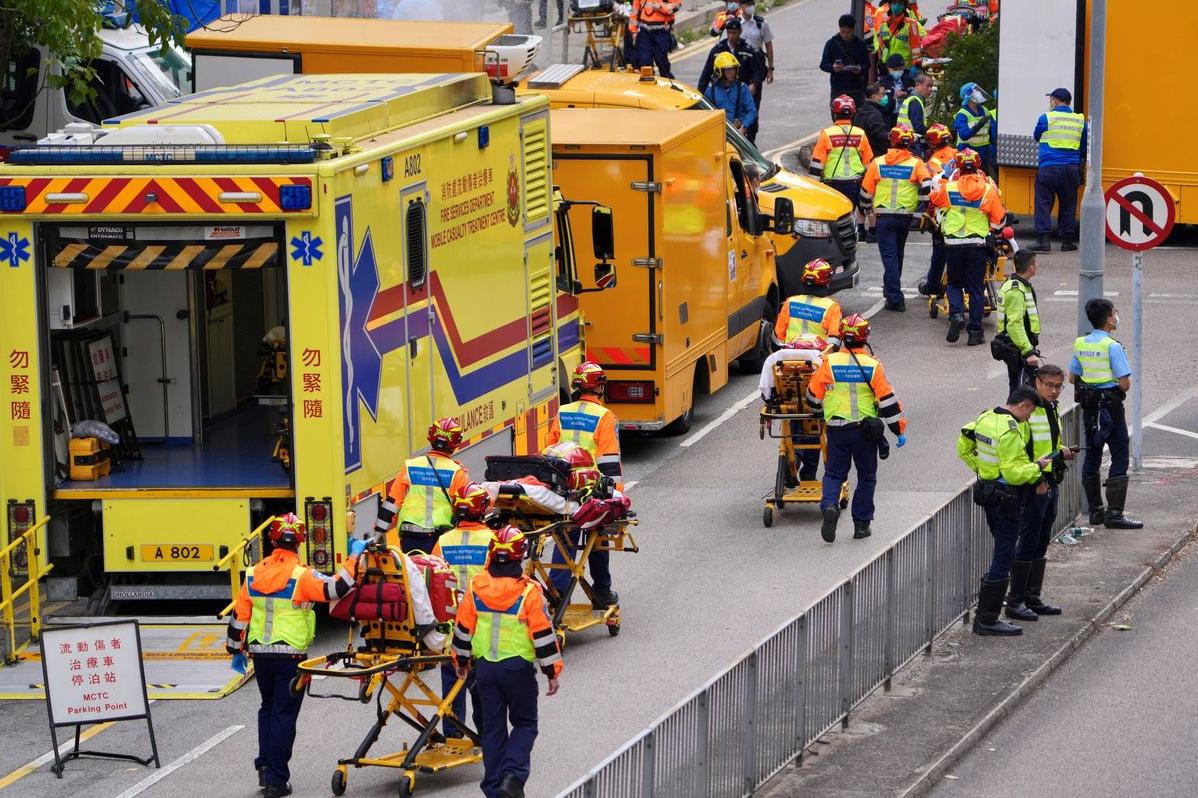Tibet Since 1951: Liberation, Development and Prosperity
China Daily | Updated: 2021-05-22 10:15
II. Peaceful Liberation
To address the complex and changing international landscape and the difficult situation in Tibet, and to satisfy the Tibetan people's wish for liberation as soon as possible, Mao Zedong wrote a letter to the CPC Central Committee while in Manzhouli on his way to the Soviet Union for a visit in December 1949. In the letter, Mao made the strategic decision that "it is better for the PLA to enter Tibet sooner rather than later."
-The victory in the Qamdo Battle created the conditions for the peaceful liberation of Tibet.
Considering the difficulties of transport and the ethnic and religious characteristics of Tibet, Mao Zedong proposed two basic principles-to prioritize a political settlement, and to avoid undue haste in liberating Tibet. The Central People's Government organized and carried out a lot of work in political persuasion, sending delegates or delegations to Tibet for mediation on several occasions in order to achieve peaceful liberation, a strategy with proven success for Beiping (Beijing), Suiyuan and Xinjiang. In February 1950, the Northwest Bureau of the CPC Central Committee sent a Tibetan official named Zhang Jingcheng to Tibet with a letter from Liao Hansheng, then vice chairman of the Qinghai Provincial People's Government, directed to the 14th Dalai Lama and Regent Taktra Ngawang Sungrab. In March, an eminent Han monk, Master Zhiqing, who had good contacts in the political and religious circles of Tibet, set out for Tibet from Chengdu, with the approval of the CPC Central Committee and the support of the Southwest Bureau. In July, a delegation composed of members from Qinghai temples and monasteries, led by Taktser Rinpoche of Kumbum Monastery, set out from Xining. Sherab Gyatso, vice chairman of the Qinghai Provincial People's Government and a leading Tibetan scholar, delivered a radio talk, calling on the local government of Tibet to "quickly dispatch plenipotentiary representatives to Beijing for peace talks". Also in this month, a delegation including the 5th Gedar Tulku of Beri Monastery in Garze, Xikang, went to Tibet.
However, these mediation activities suffered obstruction from Western imperialists and pro-imperialist separatists in Tibet. In the meantime, in spite of local economic decline, the separatists from the upper classes of Tibet expanded the Tibetan army and dispatched troops in an attempt to halt the PLA's advance. They also colluded with their imperialist supporters to set up radio stations, spread rumors to deepen the rifts among the Han and local people, and dispatched a "goodwill mission" to seek support from other countries.
In the circumstances, Mao Zedong and the CPC Central Committee realized that the liberation of Tibet was a matter of extreme urgency. Under the unified deployment of the Central People's Government, the southwest and northwest bureaux of the CPC Central Committee issued a prompt order for troops to stand by.
The PLA troops followed the principles that military operations should only be carried out when political persuasion failed and the troops had sufficient supplies to fight a battle. Guided by the central authorities' strategy of outflanking the enemy from various directions, the PLA, with the 18th army as the major force, advanced into Tibet from four directions and won the Battle of Qamdo in October, 1950.
After the victory, the First People's Congress of Qamdo was held. The Qamdo People's Liberation Committee was elected and a working committee for the peaceful liberation of Tibet was founded, composed of both ecclesiastical and secular representatives. The battle created the conditions for the peaceful liberation of Tibet. The Central People's Government and Chairman Mao Zedong had never given up their efforts to this end. Even during the battle, Mao Zedong urged that a local Tibetan delegation should come to Beijing as soon as possible.
-Signing the 17-Article Agreement marked the liberation of Tibet.
The victory at Qamdo gave the upper hand to the patriotic and progressive forces within the local government of Tibet, and the political situation moved in the direction of peaceful liberation. In February 1951, an "officials' meeting" of the local government of Tibet decided to send a formal delegation to Beijing to conduct peace negotiations with the Central People's Government. The 14th Dalai Lama expressed his wish for peace talks in a letter to the Central People's Government. On April 29, the Central People's Government and the local government of Tibet began official negotiations for the peaceful liberation. After serious consultations and thorough discussions, they signed the 17-Article Agreement in Beijing on May 23.
The 17-Article Agreement stipulates:
・The people of Tibet shall unite and drive out aggressive imperialist forces; they will return to the family of the People's Republic of China.
・The PLA troops shall enter Tibet to consolidate national defense.
・All foreign-related affairs of Tibet shall be dealt with by the Central People's Government on a centralized basis.
・The local government of Tibet shall actively assist the PLA to enter Tibet and consolidate the national defense.
・The Tibetan people shall have the right of regional ethnic autonomy under the unified leadership of the Central People's Government.
・The religious beliefs and customs of the Tibetan people shall be respected.
The agreement also clarified that the central authorities would not alter the established status, functions and powers of the Dalai Lama and Panchen Erdeni, and that former officials of all ranks in the local government of Tibet could continue to hold office. The signing of the 17-Article Agreement symbolized the final liberation of all the Chinese mainland, embodied the full sovereignty of the People's Republic in Tibet, united all forces to safeguard overall social stability, ensured the enforcement of the CPC's ethnic, religious, economic and cultural policies, and laid a solid political foundation for social development and reform in Tibet.
The 17-Article Agreement gained the support of all ethnic groups and people from all walks of life across the country. On May 28, 1951, the People's Daily published in full the agreement in both Chinese and Tibetan accompanied by an editorial entitled "Supporting the Agreement on Measures for the Peaceful Liberation of Tibet". The article made the point that this was the first step for the Tibetan people out of a dark and miserable past and toward a bright and happy future. Assemblies and processions were held in Beijing, Xi'an, Chongqing, Chengdu, Xinjiang and Inner Mongolia to celebrate the signing of the agreement.
On the same day, the 10th Panchen Lama and the Panchen Kampus Assembly made a statement in support of the agreement, declaring, "We will be the staunch supporters of Chairman Mao's leadership, and of the leadership of the Central People's Government and the CPC." On October 24, the 14th Dalai Lama, on behalf of the local government of Tibet and himself, sent a telegram to the Central People's Government to express his support for the agreement, which read, "Chairman Mao of the Central People's Government: This year the local government of Tibet sent five delegates with full authority, headed by Kalon Ngapoi, to Beijing in late April 1951 to conduct peace talks with delegates with full authority appointed by the Central People's Government. On the basis of friendship, the delegates of the two sides signed on May 23, 1951, the Agreement on Measures for the Peaceful Liberation of Tibet. The local government of Tibet as well as the ecclesiastical and secular people unanimously support this agreement, and, under the leadership of Chairman Mao and the Central People's Government, will actively assist the PLA troops entering Tibet to consolidate national defense, ousting imperialist influences from Tibet and safeguarding the unification of the territory and the sovereignty of the motherland."
-Implementing the 17-Article Agreement to safeguard national sovereignty and promote social development
In line with the 17-Article Agreement and between September 1951 and June 1952, the PLA troops in Tibet reached Lhasa and were dispatched to Gyamda, Gyangze, Xigaze, Lhunze Dzong, Yadong, Zayu and Gerze. For the first time in history, Tibet's 4,000-km border was fully and properly defended.
On September 6, 1952, the foreign affairs office of the Central People's Government representative stationed in Tibet was set up, taking responsibility for all the foreign-related affairs of Tibet under the leadership of the Ministry of Foreign Affairs of the Central People's Government. On April 29, 1954, in Beijing, China and India signed the Agreement on Trade and Intercourse Between the Tibet Region of China and India and exchanged diplomatic notes, abolishing the privileges India had inherited from the British invaders. On September 20, 1956, China and Nepal signed the Agreement on Maintaining Friendly Relations Between the People's Republic of China and the Kingdom of Nepal and on Trade and Intercourse Between the Tibet Region of China and Nepal, which canceled Nepal's privileges in Tibet. Henceforth, all the foreign-related affairs of Tibet would be dealt with by the Central People's Government on a centralized basis.
The Central People's Government issued a series of specific instructions and policies. Troops would be stationed in Tibet but would not depend on the local people for their grain supplies. They would operate according to a strict budget and produce what they needed. Food supplies would be guaranteed for the army itself while taking into consideration civilian needs. There would be unified procurement and economy would be practiced.
Soon after the PLA troops entered Lhasa, they set up the Qiyi and Bayi Farms, reclaiming land to provide for themselves. They also used the revenues from export of wool to support the PLA and the local people.
Encouraged by the Central People's Government, the 10th Panchen Lama returned to Lhasa from Qinghai Province to have an amicable meeting with the 14th Dalai Lama in April 1952. In 1953, the Dalai and Panchen lamas were elected as honorary presidents of the Buddhist Association of China, with Living Buddha Kundeling as vice president. In September 1954, the Dalai and Panchen lamas went together to Beijing to attend the First Session of the First National People's Congress (NPC) of the People's Republic of China, with the former elected vice-chairman of the NPC Standing Committee. On December 25, the 10th Panchen Lama was elected vice chairman of the National Committee of the Chinese People's Political Consultative Conference (CPPCC) at its First Plenary Session of the Second National Committee. From 1952 to 1957, a total of over 1,000 people in 13 groups, including ecclesiastical and secular officials, monks, and ordinary people including women and youngsters, made organized trips to other parts of the country, which strengthened connections between Tibet and the rest of the country and promoted national unity.
After the signing of the 17-Article Agreement, rapid progress was made in all social undertakings of Tibet under the leadership of the Central People's Government.
A modern education system was gradually put in place. In March 1951, Qamdo Primary School was set up-the first modern school in Tibet. In August 1952, Lhasa Primary School was founded. Soon afterwards, 28 public primary schools were set up in locations such as Xigaze and Shannan. In September 1956, Lhasa Middle School was established-the first modern and standard middle school in the history of Tibet. In September 1958, Xizang Minzu University officially opened in Xianyang, Shaanxi Province, enrolling a total of 3,460 students, most of whom were the children of former serfs.
There were significant improvements in transport infrastructure. In 1954, the Qinghai-Tibet Highway and the Sichuan-Tibet Highway, both terminating at Lhasa, were completed and opened to traffic. In 1956, Damxung Airport-Tibet's first airport-was completed, linking Beijing and Lhasa through official air services.
Modern agriculture, animal husbandry, industry and commerce began to emerge. Great efforts were made to improve crop farming and agricultural irrigation. Small factories of various sizes were built. Hospitals, banks, stores and post offices were set up in major cities and towns.
Visible progress was made in cultural undertakings. On October 1, 1953, a radio station was set up in Lhasa, broadcasting live programs in Tibetan. On April 22, 1956, the Tibet Daily started publication in both Tibetan and Chinese. A variety of rich and varied recreational activities were set up, including art troupes and social clubs. In 1954, newly-established performing groups from Tibet went on a performance tour in cities such as Beijing, Shanghai and Guangzhou. They were universally and warmly welcomed by local audiences.
























